
Corsican is a Romance language consisting of the continuum of the Italo-Dalmatian dialects spoken on the Mediterranean island of Corsica, France, and in the northern regions of the island of Sardinia, Italy, located due south.

Corte is a commune in the Haute-Corse department, on the island of Corsica, France.
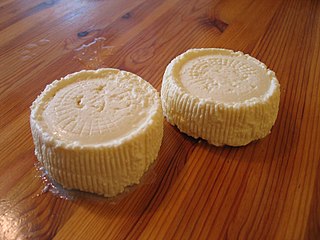
Brocciu is a Corsican cheese produced from a combination of milk and whey, giving it some of the characteristics of whey cheese. It is produced from ewe's milk. It is notable as a substitute for lactose-rich Italian Ricotta, as brocciu contains less lactose.

Corsica is an island in the Mediterranean Sea and one of the 18 regions of France. It is the fourth-largest island in the Mediterranean and lies southeast of the French mainland, west of the Italian Peninsula and immediately north of the Italian island of Sardinia, the nearest land mass. A single chain of mountains makes up two-thirds of the island. As of January 2024, it had a population of 355,528.

Tavera is a commune in the Corse-du-Sud department of France on the island of Corsica.

Omessa is a commune in the Haute-Corse department of France on the island of Corsica.

Soveria is a commune in the Haute-Corse department of France on the island of Corsica.
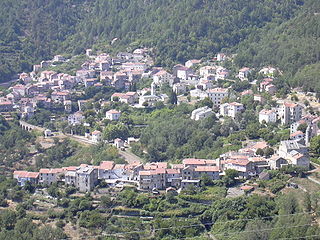
Venaco is a commune in the Haute-Corse department of France on the island of Corsica.

Vivario is a commune in the Haute-Corse department of France on the island of Corsica at the start of the climb to the Col de Vizzavona.
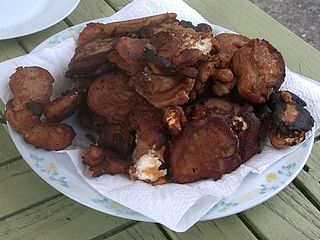
Fritelli, also Fritelle are Corsican doughnuts or fritters made from fried wheat or chestnut flour. A preparation of the fritters is referred to as Fritelli di Casgiu Frescu with fresh cheese or Fritelli di Salciccia with sausage.
The Corsican mafia is a collective of criminal groups originating from Corsica. The Corsican mafia is closely tied to both the French underworld and the Italian organized crime groups. The Corsican mafia is an influential organized crime structure operating in France, as well as North African and Latin American countries.
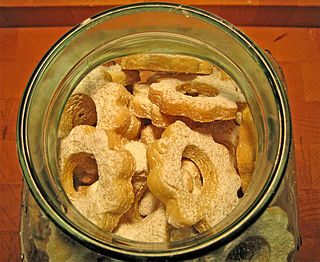
Canestrelli are a type of Italian biscuit. Originating in Montferrat, the biscuits are common in both Piedmont and Liguria. Moreover, under the name canistrelli, they are also typical of Corsica.
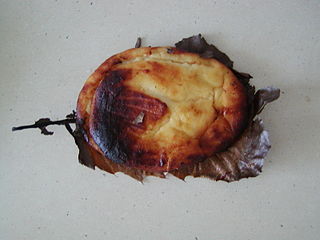
Falculelle are a typical dessert of the Corsican cuisine.

The cuisine of Corsica is the traditional cuisine of the island of Corsica. It is mainly based on the products of the island, and due to historical and geographical reasons, has much in common with Italian cuisine, and marginally with those of Nice and Provence.
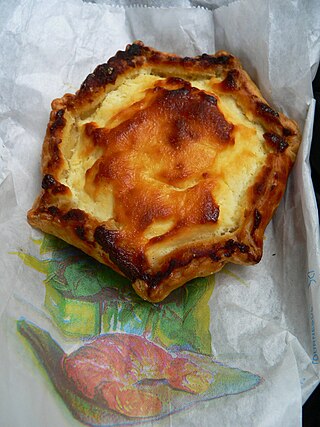
Imbrucciata is a typical Corsican dessert, similar to a small fiadone but, unlike this, it has a bottom layer of shortcrust or brisée pastry dough. The ingredients of the filling are brocciu, sugar, eggs and lemon zest.
Canestru is a Corsican cake generally shaped as a circle, made of brioche dough. The cake is typical of the cuisine of Corsica and originates from the village of Petreto-Bicchisano in Corse-du-Sud. Canestru is a traditional Easter cake, and is typically consumed during the traditional Easter Monday picnic.
Campanile, meaning "the bell tower", pl. campanili) is a Corsican cake generally shaped like a crown, made of yeast dough. It is a typical dessert of the cuisine of Corsica and is a traditional Easter cake: the boiled eggs in the cake look like little bells inside the bell tower and represent the renewed fertility of the earth after the end of winter, remembering also the tradition to unleash the bells at Easter, after having tethered them at Good Friday.

Cacavellu is a Corsican cake generally shaped as a crown, made of yeast dough. It is a typical dessert of the village of Vico.

Inuliata is a Corsican cake generally shaped as a circle, made of yeast dough. The cake is typical of the cuisine of Corsica and originates from the city of Ajaccio in Corse-du-Sud. Inuliata is prepared during the Easter week.
Strenna is a Corsican pie having generally a round shape. The pie is typical of the cuisine of Corsica and originates from the city of Vico in Corse-du-Sud. Strenna is prepared for New Year's Day, and given as present by villagers to relatives coming to offer new year's wishes.

















